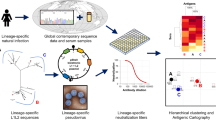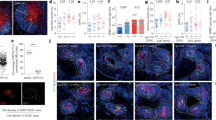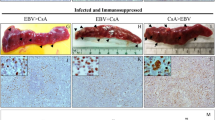Abstract
SEVERAL investigators have postulated that endogenous oncornaviruses play a role in development and differentiation, and that neoplasia is an unfortunate consequence of an otherwise important symbiosis1,2. Although attractive on theoretical grounds, these concepts remain unproven. Nevertheless, it is possible to study the relationship between viral gene expression and normal host functions. Evidence from several laboratories has suggested that expression of endogenous oncornavirus genes are under differentiation control in the mouse3–6. The clearest example of this is the case of gp70, the major envelope glycoprotein of the murine leukaemia viruses (MuLV)7–11. This protein which is coded for by the viral genome12 may be a component of the surfaces of cells which follow certain pathways of differentiation. Further, the thymocyte differentiation marker, GIX, has been shown to be a type-specific antigenic determinant of some gp70 molecules4,5.
This is a preview of subscription content, access via your institution
Access options
Subscribe to this journal
Receive 51 print issues and online access
$199.00 per year
only $3.90 per issue
Buy this article
- Purchase on Springer Link
- Instant access to full article PDF
Prices may be subject to local taxes which are calculated during checkout
Similar content being viewed by others
References
Huebner, R. J., and Todaro, G. J., Proc. natn. Acad. Sci. U.S.A., 64, 1087–1094 (1969).
Huebner, R. J., et al., Proc. natn. Acad. Sci. U.S.A., 67, 366–376 (1970).
Stockert, E., Old, L. J., and Boyse, E. A., J. exp. Med., 133, 1334–1355 (1971).
Tung, J. S., Vietta, E. S., Fleissner, E., and Boyse, E. A., J. exp. Med., 141, 198–205 (1975).
Obata, Y., Ikeda, H., Stockert, E., and Boyse, E. A., J. exp. Med., 141, 188–197 (1975).
Del Villano, B. C., Nave, B., Croker, B. P., Lerner, R. A., and Dixon, F. J., J. exp. Med., 141, 172–187 (1975).
August, J. T., Bolognesi, D. P., Fleissner, E., Gilden, R. V., and Nowinski, R. C., Virology, 60, 595–600 (1974).
Kennel, S. J., Del Villano, D. C., Levy, R. L., and Lerner, R. A., Virology, 55, 464–475 (1973).
Strand, M., and August, J. T., J. biol. Chem., 248, 5627–5633 (1973).
Hunsmann, G., Moennig, V., Pister, L., Seifert, E., and Schaefer, W., Virology, 62, 307–318 (1974).
Green, R. W., et al., Virology, 56, 565–579 (1973).
Strand, M., and August, J. T., Cold Spring Harb. Symp. quant. Biol., 39, 1109–1116 (1974).
Lerner, R. A., Wilson, C. W., Del Villano, B. C., McConahey, P. J., and Dixon, F. J., J. exp. Med. (in the press).
McConahey, P. J., and Dixon, F. J., Int. Arch. Allergy, 29, 185–189 (1966).
Lerner, R. A., et al., Proc. natn. Acad. Sci. U.S.A., 69, 2965–2969 (1972).
Laemmli, U. K., Nature, 227, 680–685 (1970).
Author information
Authors and Affiliations
Rights and permissions
About this article
Cite this article
DEL VILLANO, B., LERNER, R. Relationship between the oncornavirus gene product gp70 and a major protein secretion of the mouse genital tract. Nature 259, 497–499 (1976). https://doi.org/10.1038/259497a0
Received:
Accepted:
Issue Date:
DOI: https://doi.org/10.1038/259497a0
Comments
By submitting a comment you agree to abide by our Terms and Community Guidelines. If you find something abusive or that does not comply with our terms or guidelines please flag it as inappropriate.



